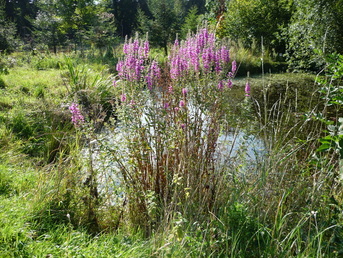Fish ponds and moat
The moat and two ponds are thought to be of mediaeval origin but to have survived so long they must have been dug out a number of times. The ponds no longer contain fish but this makes them a much better wildlife habitat for invertebrates such as dragonflies and amphibians such as newts. The water in both ponds is of good quality as shown by a survey carried out by the Guides and other earlier surveys.(Surveys and Records) Water plants found in and around the edges of the ponds include flag iris, bog bean, water mint, purple loosestrife, hornwort, water fringe.
The moat and two ponds are thought to be of mediaeval origin but to have survived so long they must have been dug out a number of times. The ponds no longer contain fish but this makes them a much better wildlife habitat for invertebrates such as dragonflies and amphibians such as newts. The water in both ponds is of good quality as shown by a survey carried out by the Guides and other earlier surveys.(Surveys and Records) Water plants found in and around the edges of the ponds include flag iris, bog bean, water mint, purple loosestrife, hornwort, water fringe.
The second pond (nearest the picnic tables) has many invertebrates including dragonfly, damselfly and mayfly nymphs, leeches, freshwater hoglouse, various beetles, pond skaters, and water boatmen. We use this pond for pond dipping with children. The other pond is shallower and more overshadowed by trees but it still has a good variety of wildlife. Both ponds have had frogs, toads and newts with their spawn and tadpoles. Mallard ducks and moorhens are frequently seen on the moat and ponds; they breed on the island which is a relatively safe site. Squirrels are often seen along the boardwalk fence.

